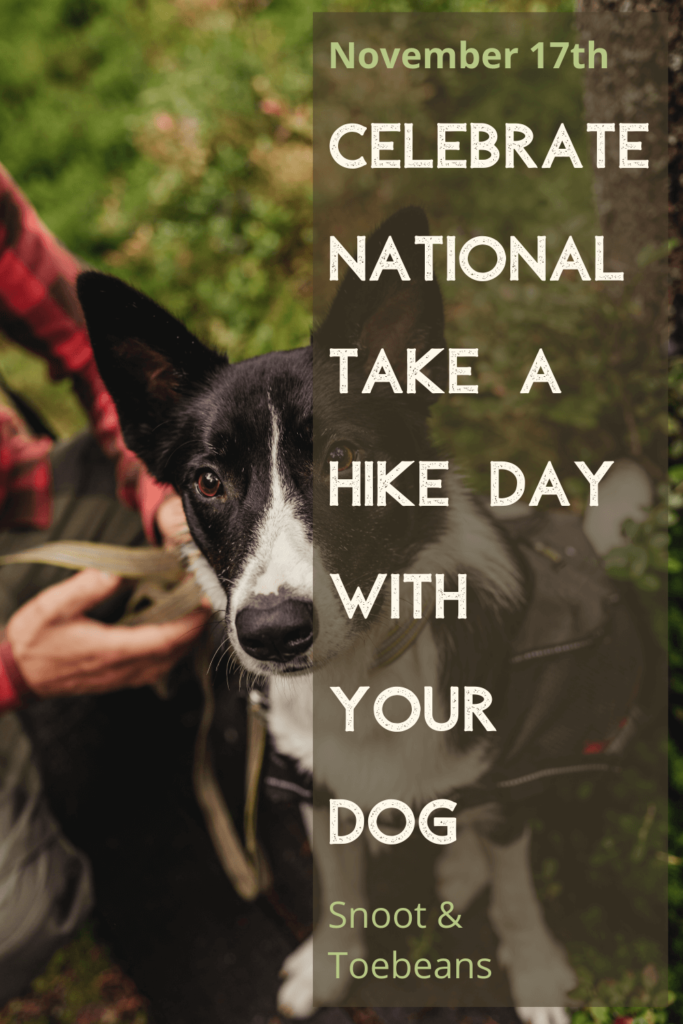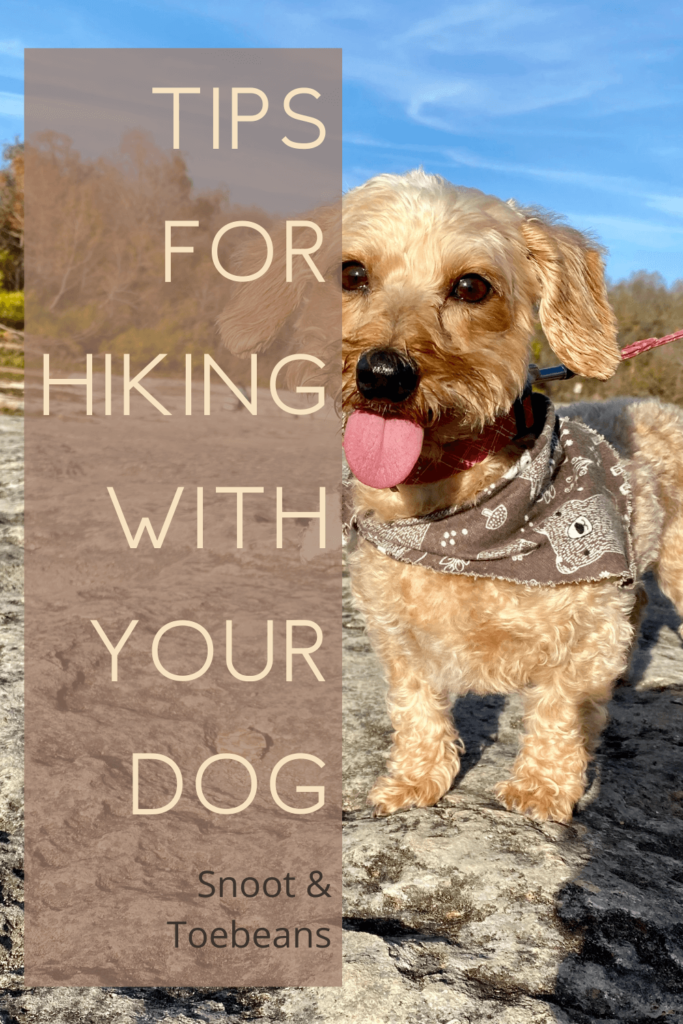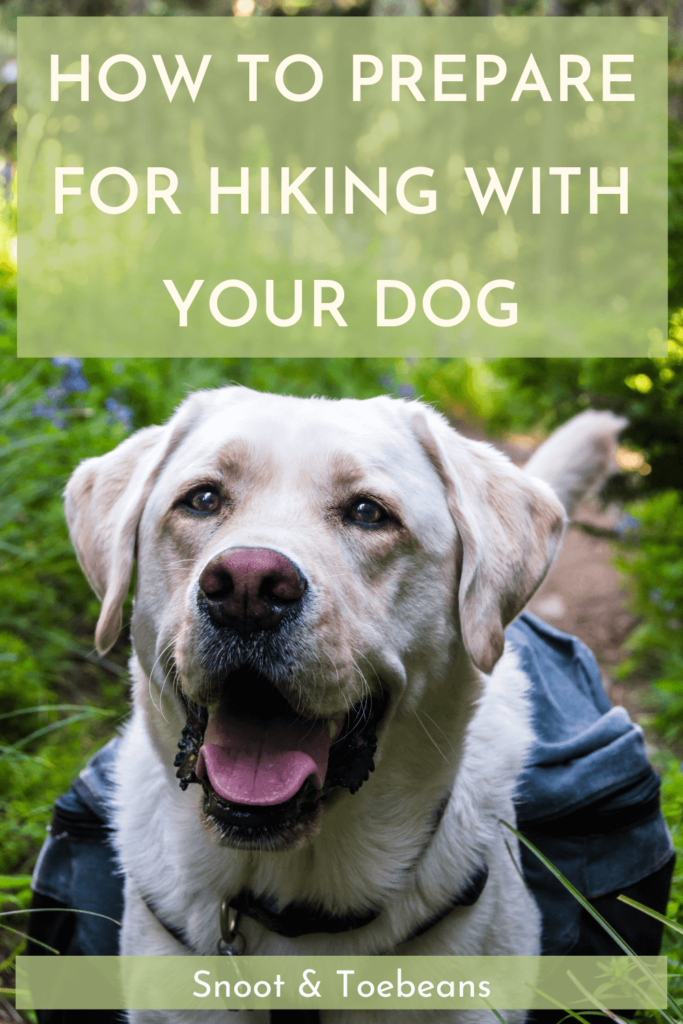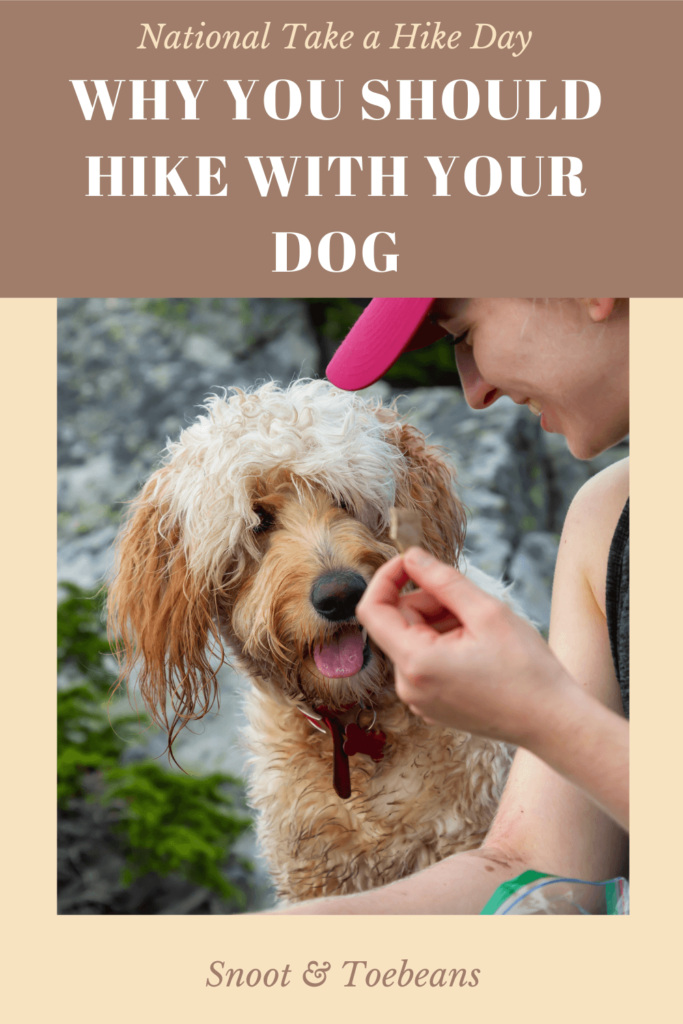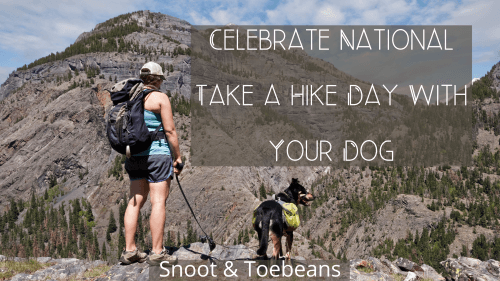Disclosure: My dog blog is supported by dog parents just like you. I only recommend products that I would use on my dogs. All opinions expressed here are my own. I sometimes earn a small affiliate commission, at no extra cost to you, when you click through the affiliate link and purchase something. You can read more about my affiliate policy here.
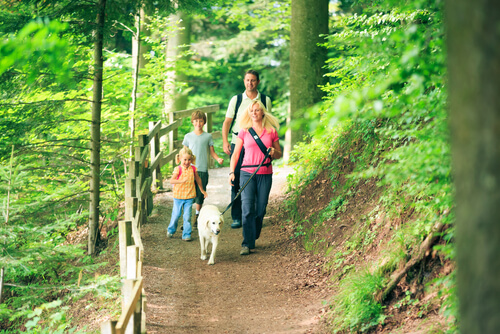
National Take a Hike Day is November 17th every year. Y’all, I can’t think of a better way to celebrate this day than hiking with your dog.
Certainly, your dog makes the perfect hiking companion. I know my dogs are always ready for an adventure. As a result, your live-in companion will be curious about the natural surroundings.
Therefore, your hiking experience will be enhanced, making you notice and appreciate the nature of the hike. In addition, you will have some quality bonding time while hiking with your dog.
Furthermore, hiking with your dog is great exercise physically for both of you. Not to mention, both of you will benefit mentally. To clarify, all of those natural smells, sights, and sounds are bound to be invigorating and rejuvenating.
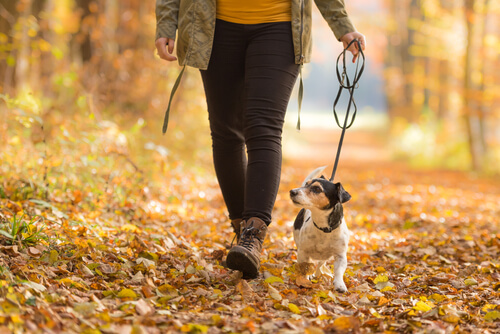
I mean, seriously, hiking with your dog is a great opportunity to escape the stress of daily routines. And, you both will reset your minds and bodies.
So, we’ve established some good reasons to go hiking with your dog on National Take a Hike Day. Or, really, to make hiking a regular outing. However, it is not a good idea to hit the trail without being prepared.
Most importantly, you need to think of hiking with your dog in three steps. Firstly, prepare before your hike. Secondly, what to attend to during your hike. And, thirdly, what needs to be done after your hike.
Before Hiking With Your Dog
Preparing before you even go hiking with your dog takes as much time as the hike itself. In other words, it is very important! For starters, you need to analyze if your dog is healthy enough and fit enough for a hike.
In addition, you need to ask yourself if your dog is well-behaved enough? For instance, your dog will need to be cooperative on the trail shared with others.
Furthermore, make sure your dog is up to date on their vaccinations and their ID tags are current.
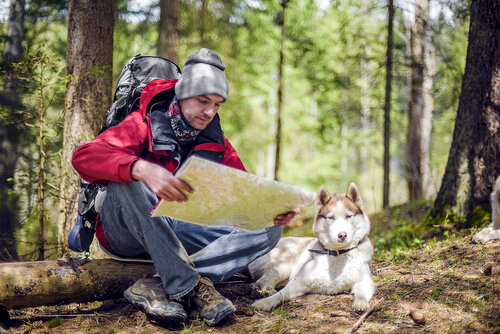
Next, you need to figure out where you’ll go hiking with your dog. It’s probably best to avoid trails shared with mountain bikers and horses. In addition, do some research, because not all trails allow dogs.
While researching, learn about the rules for the area of your chosen trail. For example, National Parks have general pet rules. However, each park may have additional regulations.
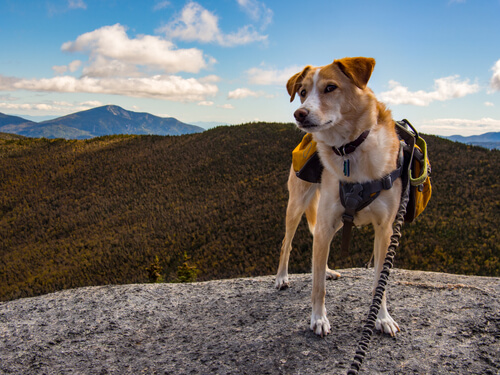
Then, pack a backpack for both you and your dog with essentials that include items for an emergency. If your dog will be carrying a backpack, then know how much weight your dog can carry.
Young, healthy dogs can carry 25% of their weight. However, check with your vet for appropriate weight for your dog.
What Should Be in Your Backpack?
- Map and a compass
- Flashlight
- First aid supplies, such as plastic bandages, gauze bandages, and some aspirin
- Sun protection, such as sunglasses and sunscreen
- Food and water
- Matches in case of an emergency
- Compact multi tool
- Basic repair kit that includes a 20-foot length of nylon cord, a small roll of duct tape, 1-inch webbing, extra webbing buckles and super glue
- Extra-large garbage bags, or a reflective space blanket, or a tube tent to use as an emergency shelter
You can also check out this day hiking checklist.
What Should Be in Your Dog’s Backpack?
- Food and Treats. It is a good idea to pack more food and treats than what you think your dog needs. Furthermore, plan to give your dog the food and treats regularly to keep their energy level up. The easiest food to pack and carry while hiking with your dog is dry kibble.
- Water and a Collapsible Bowl. So, just like with food and treats, you need to pack extra. And, you need to offer it frequently to your dog throughout the hike. A rule of thumb is to carry eight ounces of water per dog, per hour of hiking. Another tip is if the weather is hot, freeze the water at ¾ full the night before. In addition, a collapsible bowl is lightweight and can easily be attached to your dog’s leash.
- Leash and Collar, or Harness. Plan to keep your dog on a leash while hiking. Most importantly, it is for your dog’s safety. However, leashes might be part of the rules and regulations of the area you are hiking in. Plus, it is common courtesy to keep your dog leashed, because you are sharing the trail with others. Make sure that your dog’s collar or harness fits correctly. For example, it needs to be loose enough for comfort, but tight enough to not easily slip off. And, another good rule of thumb is to pack an extra leash. That is to say, that there is the possibility that your dog’s regular leash might break.
- ID Tags and/or Microchip. So, with the collar or harness mentioned above, make sure your dog’s ID tags are attached. Nevertheless, a collar can be lost while hiking, so having your dog microchipped could ensure being reunited. Be sure to secure the ID tags with a durable loop ring, rather than a s-hook.
Dog Essential Supplies Continued
- Dog First Aid Kit. Hopefully you will not have to use this. However, you need to have one packed. You can make your own first aid kit for your dog, or you can purchase one. But, be sure to include hydrogen peroxide, scissors, bandages, gauze pads, and tweezers. Therefore, the hydrogen peroxide can be used to disinfect cuts. The scissors can be used to trim hair around wounds, and tweezers can remove foreign objects. In addition, you can take dog first aid classes at Petco or the Red Cross.
- Plastic Bag, Poop Bags or Trowel. Park rules and regulations will require you to clean up after your dog. So, poop bags that can be purchased in a roll will enable you to carry your dog’s waste out. Furthermore, you can tie a larger plastic bag to your backpack to contain the used poop bags. However, another alternative is to pack a trowel that can be used to bury your dog’s waste. For instance, dig a small hole six to eight inches deep in the dirt. And, make sure the hole is at least 20 feet away from the trail, water, and campgrounds.
In addition, some extra supplies you might want to pack, include:
- Insect repellent
- Clothing such as, a reflective jacket, bandanas, booties
- Dog towel
- Dog brush or comb
During Hiking With Your Dog
Now that you are prepared, it’s time to attend to some things on your chosen trail. Therefore, you can start by getting acquainted with the National Parks B.A.R.K rule while hiking with your dog.
- Bag your pet’s waste
- Always leash your pet
- Respect wildlife
- Know where you can go
Plus, you and your dog can be respectful hikers by following The Seven Principles of Leave No Trace.
- Plan ahead and prepare.
- Travel and camp on durable surfaces.
- Dispose of waste properly.
- Leave what you find.
- Minimize campfire impacts (be careful with fire).
- Respect wildlife.
- Be considerate of other visitors.
Certainly, it is important to understand that not all fellow hikers are comfortable with dogs. Not to mention, that there may be other dogs on the trail who aren’t as friendly as yours. Therefore, for safety, courtesy and control, make sure your dog is leashed.
Most importantly, although many hiking trails are dog-friendly by law, yield to hikers without a dog. Consequently, they have the right of way.
However, it is a good idea to greet others on the trail. As a result, this signifies that your dog is friendly. Furthermore, your friendly hello reassures your dog that people approaching are okay.
Things such as poison oak or a venomous snake can be avoided by staying on the trail and out of the brush.
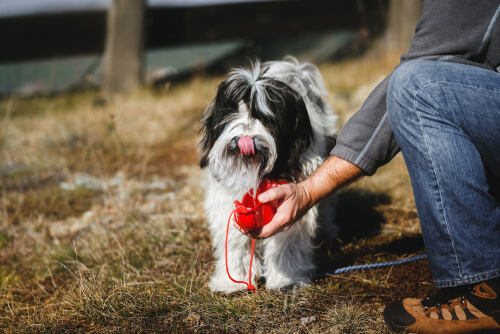
Furthermore, teach your dog to drink from the collapsible bowl you packed during preparation. Likewise, teach your dog NOT to drink water from any sources along the trail. Just like us, dogs are susceptible to water-borne diseases.
Be sure to check for cracks or tears on your dog’s paw pads when you stop to refuel. For instance, there could be serious damage by the time they show signs of limping.
And speaking of refueling, allow time for frequent rests and breaks for both you and your dog. That is to say, your energy level will be boosted with rest, food, and water. Plus, you don’t want to run the risk of dehydration for either of you.
After Hiking With Your Dog
Hiking with your dog isn’t over until you make sure all is well with them. For instance, you need to thoroughly examine your dog.

Firstly, check your dog’s entire body for ticks, burrs, and anything else stuck in their fur or skin. A good tool to use for this is a fine toothed tick comb.
Therefore, you will be able to remove any embedded items that you can miss with your eyes. Furthermore, check for any cuts, scrapes, and bug bites.
Secondly, check your dog’s paw pads for cracks or tears that you might have missed on the trail. There are several paw balms, on the market for purchase, to choose from. Consequently, these balms will moisturize your dog’s paw pads and give an extra layer of protection.
However, you can try a DIY balm with all natural ingredients. Plus, you will save money in the long run! We’ve developed a couple of recipes for you to try, paw balm and paw butter bars.
Thirdly, give your dog a bath to get rid of anything else.
In Conclusion
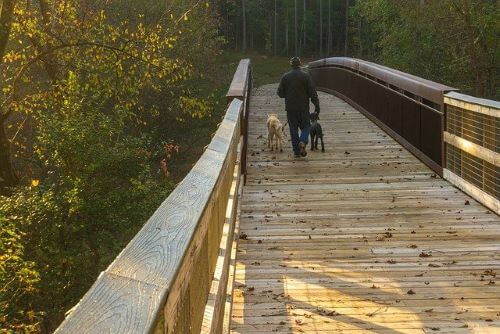
So, hiking with your dog can be a great way to celebrate National Take a Hike Day. And, with some planning, hiking with your dog can be very rewarding and a great bonding experience.
There are a few more tips to think about when hiking with your dog.
- If your dog has never hiked before, then ease your dog into a hiking routine. To clarify, start with shorter, easier trails. Then, work your way to a harder trail or an all-day adventure.
- Plan to hike less frequented trails if you have an anxious dog.
- Be alert to your surroundings. For instance, pay attention to the terrain and any debris or broken glass. Furthermore, be aware of other hikers, animals, and mountain bikers.
- Lastly, make sure someone knows where you will be and when you will be back. Keep in mind, you can’t always rely on having cell service.
Do you have any other hiking routines or tips or advice not mentioned above? We’d love to read about your experiences in the comments below.
You might want to read these posts:
- Dog First Aid – the Essentials to Know
- Walking Your Dog – Why It’s So Important!
- Dog Paw Protection Tips for the Summer
- Keep Dogs Hydrated – 5 Tips to Beat The Heat
You can save this post to your Pinterest by using one of the following images to pin.
